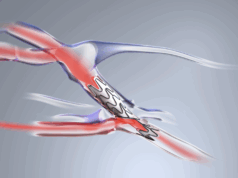Ultrasound is a powerful tool for assessing haemodialysis (HD) access for maturity, but may also be used to guide HD access cannulations and has the potential to “actually change the process of care” according to Vandana Dua Niyyar (Emory University, Atlanta, USA), who spoke to Renal Interventions at VEITHsymposium (15–19 November, New York City, USA). Niyyar emphasizes the value of ultrasound throughout the spectrum of kidney disease, right from the first visit of the patient to the nephrologist, while also noting its wider variety of applications including assessment and cannulation of dialysis access.
Cannulation has traditionally been done by experienced dialysis staff, she says, but with the increased turnover in dialysis staff after the COVID-19 pandemic, combined with the subjective nature of cannulation criteria, there is plenty of room for the extra objectivity provided by ultrasound. As an “adjunct to physical examination and experience”, she says, it can transform the patient experience.
Addressing the changing landscape of fistula creation, Niyyar praised the influence of new technology in the field. While technology is already being used in the creation of fistulas, it’s also worth putting it to use for the end user. She referenced patients with complex anatomy that she doubted would have been successfully cannulated without ultrasound. Niyyar said that the technology is able to “actually change the process of care”, which she stated had been “stagnant for quite a few years” despite technological advances in AVF creation. Ultrasound and other new technologies offered an opportunity to review how care was provided and a chance to “challenge the status quo”.
“I don’t think an ultrasound should replace anything,” Niyyar stipulated, “but the ultrasound in combination with experience and physical examination can change the trajectory of what the patient experiences at the end point”. She repeatedly stressed the importance of the patient experience, in fact, saying that is “ultimately what we are here for”. However, ultrasound has its limitations, she admitted. Though the ultrasound she uses is handheld, easy to “carry directly to the patient, and “relatively inexpensive”, it lacks flow measurements, she said. This is due to be remedied in future versions of the point-of-care ultrasound, she noted.










